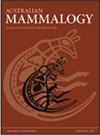大陆宽齿大鼠(Mastacomys fuscus mordicus)在野火后恢复
IF 0.9
4区 生物学
Q3 ZOOLOGY
引用次数: 0
摘要
野火被认为是对受威胁的宽齿鼠(Mastacomys fuscus mordicus)的主要风险,宽齿鼠是一种本地鼠状啮齿动物。科希丘什科国家公园是该物种的重要据点,引发了人们对2019-20年火灾对该地区发生的人口影响的担忧。2016年至2017年,科学家们重新考察了62个已知被该物种占领的烧毁地点。火灾发生一年后,几乎没有发现宽齿鼠的证据,只有8%的遗址发现了其独特的粪便。所有这些地点都有一些未燃烧的植被。相比之下,在51个未被烧毁的地点中,80.4%的人在火灾前和火灾后的调查中都有宽齿鼠的证据。火灾发生两年后,在42%的烧毁地点发现了粪便,主要发生在草地内(n = 23),其中3个在森林栖息地。火灾发生三年后,在66%的地点检测到粪便,其中30个在草地,11个在森林沟壑区,1个在低坡度灌木林地。根据恢复轨迹,很可能在随后的几年中(在没有火灾或对其他竞争威胁进行适当管理的情况下),所有剩余的先前占用的地点都可能重新填充。本文章由计算机程序翻译,如有差异,请以英文原文为准。
Mainland broad-toothed rat (Mastacomys fuscus mordicus) recovery after wildfire
Wildfires are considered a major risk to the threatened broad-toothed rat (Mastacomys fuscus mordicus), a native murid rodent. Kosciuszko National Park is an important stronghold for the species, raising concern regarding the impact of the 2019–20 fires on populations occurring in this area. Sixty-two burnt sites known to be occupied by the species in 2016–17 were revisited. One year after the fires, little evidence of the broad-toothed rat was found, with its distinctive scats located at just 8% of sites. All these sites had some unburnt vegetation present. In contrast, 80.4% of 51 unburnt sites had evidence of the broad-toothed rat in both the pre- and post-fire surveys. Two years following the fire, scats were found at 42% of burnt sites, predominantly occurring within grassland (n = 23), with three in forested habitat. Three years following the fire, the scats were detected in 66% of sites, comprising 30 in grassland, 11 in forested gully and the first in lower slope shrubland. Based on the recovery trajectory, it is likely that in subsequent years (with the absence of fire or the adequate management of other competing threats) all remaining previously occupied sites may be re-populated.
求助全文
通过发布文献求助,成功后即可免费获取论文全文。
去求助
来源期刊

Australian Mammalogy
ZOOLOGY-
CiteScore
2.50
自引率
8.30%
发文量
26
期刊介绍:
Australian Mammalogy is a major journal for the publication of research in all branches of mammalogy. The journal’s emphasis is on studies relating to Australasian mammals, both native and introduced, and includes marine mammals in the Antarctic region. Subject areas include, but are not limited to: anatomy, behaviour, developmental biology, ecology, evolution, genetics, molecular biology, parasites and diseases of mammals, physiology, reproductive biology, systematics and taxonomy.
Australian Mammalogy is for professional mammalogists, research scientists, resource managers, consulting ecologists, students and amateurs interested in any aspects of the biology and management of mammals.
Australian Mammalogy began publication in 1972 and is published on behalf of the Australian Mammal Society.
 求助内容:
求助内容: 应助结果提醒方式:
应助结果提醒方式:


